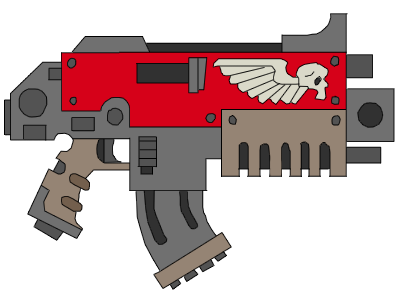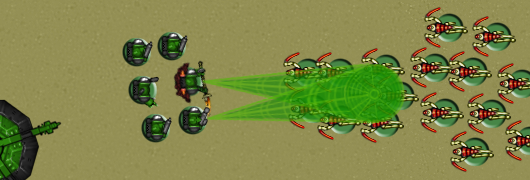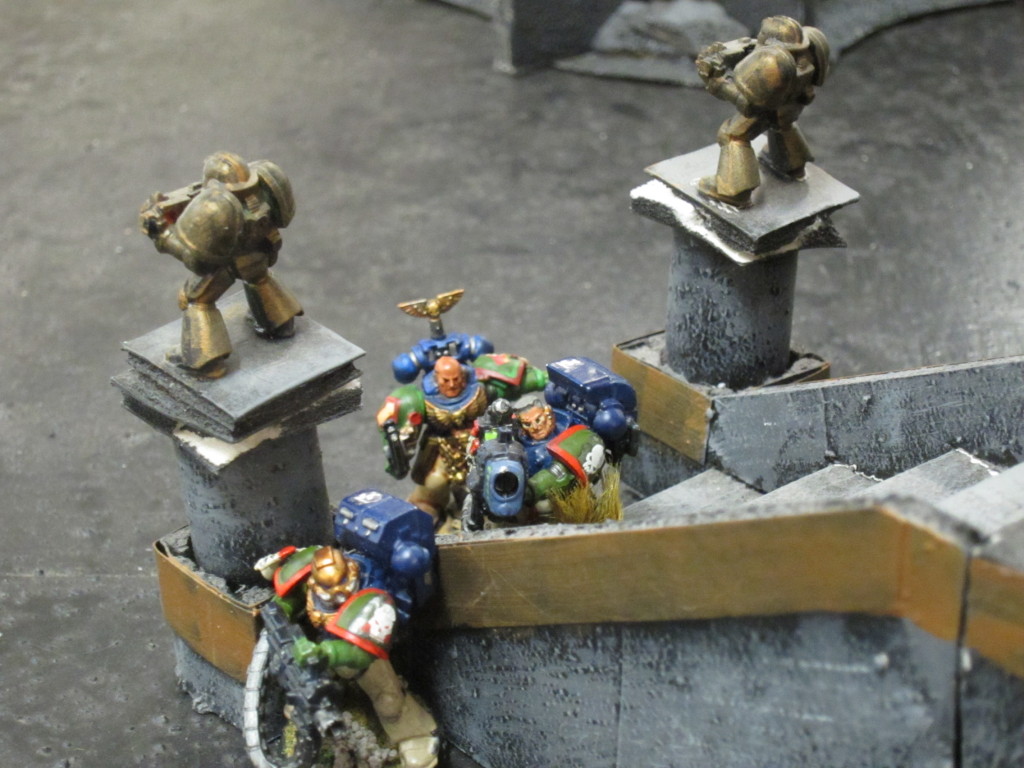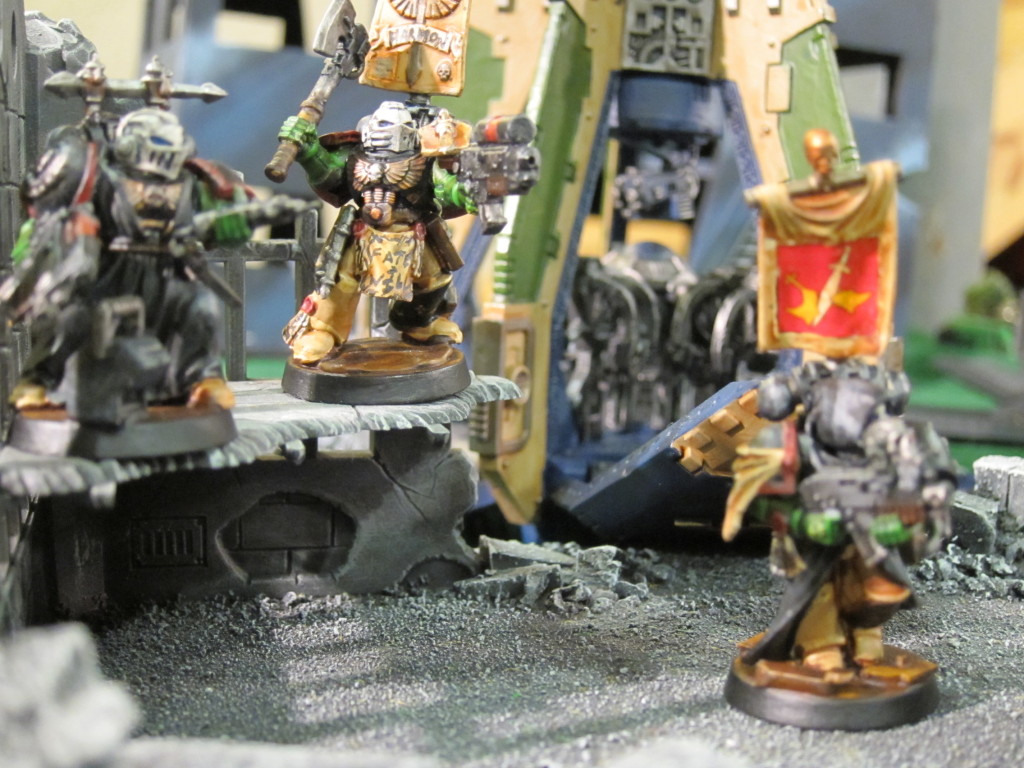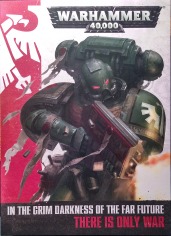 As most have no doubt heard already even if they haven’t yet gotten their own rulebook or given it a play, shooting in 7th edition 40k has been updated. The changes aren’t earth shattering, especially in casual play, but they are worth taking note. For example, Focus Fire is gone, so you can no longer specifically target just models outside of cover and pile more wounds onto them. Although that was useful and a good tactic, I don’t see its removal as a terrible loss. I doubt most players, particularly outside competitive play, had ever even used it much.
As most have no doubt heard already even if they haven’t yet gotten their own rulebook or given it a play, shooting in 7th edition 40k has been updated. The changes aren’t earth shattering, especially in casual play, but they are worth taking note. For example, Focus Fire is gone, so you can no longer specifically target just models outside of cover and pile more wounds onto them. Although that was useful and a good tactic, I don’t see its removal as a terrible loss. I doubt most players, particularly outside competitive play, had ever even used it much.
What I want to discuss briefly is the change to the order in which weapons fire. It also is neither a huge change nor one I consider negative, but it does have consequences on how you shoot, and depending on how you look at it either reduces the effectiveness or changes the tactics for some weapons loadouts.
If you spot any needed corrections to my understanding or have thoughts on the handful of open questions, please share them in the comments below!
Sixth Edition
Previously, all weapons fired simultaneously. All rolls to hit and wound for pistols, flamers, boltguns, etc., were conceptually all done at the same time. This could lead to some funny effects that weren’t game breaking, particularly as they generally only came up infrequently, but definitely weird if you even noticed it.
For example, suppose I have a couple Ultramarine Tacticals with a meltagun staring down some Chaos Marines and their buddy Abaddon, as in the figure below. All of the Ultramarines are within 12″ of one Chaos Marine. Another traitor and Abaddon are not. Clearly, the two boltgunners can double tap for 2 shots on the first guy, and the meltagunner is also in range to shoot. Somewhat weirdly though not obviously so, by the 6th edition’s “Out of Range” rules (pg 16), I could apply all of those boltgun shots to all the enemy models even though I got 2 extra shots for the one guy alone being in half range (12″). Really weirdly if you stop to think about it, by those rules I could also use the boltgun shots to take out the two Chaos Marines and then apply the meltagun shot to Abaddon, much better for me, even though he is completely out of range for that weapon.
Similarly, suppose I have two Tacticals with boltguns and one with a flamer facing off against Hormagaunts coming out of some ruins as below. I’d like to apply the flamer wounds to the guys in the back to negate their cover save. By those same “Out of Range” rules in 6th edition, I could do that even though the template doesn’t reach them. Everything shoots at once, and say everything hits and wounds (quite conceivable). I allocate the bolter wounds first and the front three Hormies are dead, maybe one guy in the back makes his cover save on the remaining bolter shot. I then apply the flamer wounds and the back guys are denied cover and die.
Seventh Edition
Relatively minor as they were in the overall scheme of 40k weirdness, seventh edition eliminates those oddities. Now, you activate a unit to shoot with and nominate a particular weapon class, e.g., boltgun or flamer, further defined below. All of the weapons of that class in the unit may fire, and all of the hits, wounds, and casualty removal for those shots is resolved simultaneously before nominating and resolving another weapon class. Players can still elect to not shoot with particular models for any given weapon class, but cannot go back to that weapon class to shoot with them later in the order. Models still of course cannot fire more than one weapon in a shooting phase unless they’re specifically permitted to do so, e.g., vehicles, Techmarines with a Servo-Harness, some characters.
Most importantly: It’s implied by the new ordered shooting, but the revised “Out of Range” rules (page 35) then make very clear that enemy models cannot be removed if they’re not in range of the models and weapon class currently firing. In the above examples, that means I need to nominate the meltagun and flamer before the boltguns or risk wasting the special weapons. Firing the boltguns first might remove potential casualties within the special weapons’ lesser range, while the boltguns could have shot models in the rear even with those in front removed.
Notably, weapon class is determined by the combination of name, ammo, and mode. So, bolt pistols and boltguns are different weapons even though they both fire bolter shells with the same damage stats. Ammunition is also clear; Sternguard firing their Dragonfire bolts (24″ range, ignores cover) shoot at a different order step than Sternguard firing Vengeance rounds (18″ range, AP3, Gets Hot).
Unfortunately, I don’t believe a formal definition of weapon mode is given in the rules. Perhaps not totally obviously, it all but certainly means differentiating between rapid fire weapons double tapping at half range versus shooting single shots at full range. Salvo weapons firing stationary versus moving are a more intuitive example of different modes. Importantly, the rules explicitly state that the maximum range for a weapon is applied regardless of the mode used. In the topmost example above, if the boltguns fire first, rapid fire due to an enemy being in 12″, and produce four wounds, all four would be applied even if that single model within half range to double tap is removed. The rules justify this as the shots flying on and getting lucky. Sounds reasonable to me, and makes sense in terms of a small practical convenience and not diminishing those weapons.
Similarly to not defining weapon modes, I don’t believe the rules explicitly state whether mastercrafted and twin-linked weapons fire at different times from the regular weapon. Given the focus on ordering weapons by “different names,” they all but certainly do when purchased as entries with those adjectives in the army list. More tricky is whether or not they count as different names when purchased the same but upgraded through some other mechanism. For example, is a Salamanders Sergeant’s boltgun that has been mastercrafted via their chapter traits different from the other boltguns in his squad? I would have to assume so given that you would have to roll different dice for those weapons anyway.
Fortunately, the rules do make clear that combi-weapons fire at the same time as whichever component you are choosing to fire, e.g., boltgun or meltagun.
Flame Away!
Given those rules, there are a few new tactical considerations, the most obvious ones revolving around range, templates, and blasts.
For example, units with different classes of flamers now need to be maneuvered with more care and in different fashion than before. The figure below shows one of my favorite setups and tactics: Vulkan and some Tactical buddies leap out of a Drop Pod to double flame a blob of baddies in a column. Unfortunately for me, either Vulkan or the flamer now has to resolve shooting first. In the arrangement below, that’s going to completely remove all the enemies in template range, wasting the other flamer. Previously the Salamanders here would almost certainly eliminate the entire blob (16 Hormagaunts versus 14 definite flamer kills and 9 remaining bolt shots: 2/9 hits+wounds needed to eliminate). Now they’ll severely cripple but almost certainly not completely remove the Tyranids (16 Hormagaunts versus 7 definite flamer kills and 9 remaining bolt shots: 9/9 hits+wounds needed to eliminate).
At first I was thinking this made mixed-flamer teams inefficient, and it does in some precise configurations like this one. But really I’ll just have to think more about how I deploy and move them. For example, looking at that blob, I need to put higher priority than before on landing and moving to the right, top, or bottom of it, so that both flamers will have at least some targets even after casualty removal. This consideration applies for some other units as well. Presumably Vulkan’s Gauntlet is not a heavy flamer in terms of having different names for shooting ordering, even though his entry says “The Gauntlet … is a heavy flamer.” So I have this same issue even if he comes down with heavy flamer toting Sternguard. Somewhat more difficult to accommodate given the practicalities of Drop Pods, movement, and terrain would be a Sternguard squad wielding a mix of heavy flamers and combi-flamers. In my experience the heavies would frequently render the combi-flamers useless. Another unit with the same new challenge is a Blood Angels Dreadnought equipped with a heavy flamer and twin linked heavy flamer.
Tactics
Generalizing from that, these changes to shooting aren’t huge but do require additional care. Right now I’m working on developing my rules of thumb for ordering shots in common situations. At the top level it’s pretty clear that should generally follow increasing range with exceptions to maximize templates, blasts, and rapid fire/single shot flexibility, something like:
- ~9″ Templates
- 8″ Grenades
- 12″ Pistols
- 12″ Rapid Fire
- 24″
- 36″
- 48″
For my Marines the details of those rules of thumb, largely for Tacticals, so far are:
- Heavy flamers
- Flamers
- Combi-flamers (save for last of flamers in case they’d be useless to pop)
- Frag grenade (after the flamers as the former are generally more likely to wound, particularly for Salamanders) or krak grenade (not actually sure if it doesn’t make sense to put this first, before flamers, given the limited range)
- Meltaguns
- Plasma pistols (after meltaguns to avoid gets hot if not needed)
- Bolt pistols (after meltaguns and plasma pistols if potentially assaulting to delay decisions (see below); otherwise, before plasma pistols)
- Frag missiles (fired here to maximize models under the blast, moved after rapid firing if there’s a bunch of enemies outside 12″ range, and again to after single-shots if there are clusters beyond 24″ range)
- Plasma cannons (fired here to maximize models under the blast, moved after rapid firing if there’s a bunch of enemies outside 12″ range, and again to after single-shots if there are clusters beyond 24″ range)
- Rapid-firing boltguns
- Rapid-firing plasmaguns (after boltguns to avoid gets hot if not needed)
- Storm bolters (moved before bolt pistols if potentially assaulting)
- Multi-meltas
- Single-shot boltguns
- Single-shot plasmaguns (after boltguns to avoid gets hot if not needed)
- Heavy bolters
- Krak missiles
- Lascannons
Obviously actual circumstances would dictate changes to the ordering, e.g., moving meltaguns up or down depending on where the toughest armor is in the opposing unit. Some orderings also don’t matter, like multi-meltas versus single-shot boltguns or krak missiles versus lascannons. But that’s the kind of general priorities I’m trying to get into my head.
One interesting note is that the order isn’t declared in advance. That’s helpful if you’re looking at potentially assaulting a unit. Again thinking mostly about Marines, if you have some flamers, a special pistol on your sergeant, meltaguns, and/or use a grenade, you could shoot at a unit a bit before making a decision about whether or not to use bolt pistols with the bulk of your squad so you can assault, or use rapid firing boltguns to try and finish it off in shooting instead if it’s been severely diminished. Similarly, the ordered shooting allows you to have a bit more information before you have to decide whether or not to shoot with every model or weapon in cases where that might risk putting the target out of realistic assault range.
Conclusion
Other than probably needing some tweaks to army construction and potentially but not necessarily a few of the psychic powers, I’m pretty optimistic about seventh edition. I don’t think there are many new things that will slow down the game more once people are used to them, including this new shooting algorithm as well as the psychic phase. Several of the changes, like the vehicles updates, have actually brought more balance to the game, while others like this revised shooting have fixed some oddities. My early thoughts are it should be a really good era of 40k once tournaments figure out what they need to tweak.


